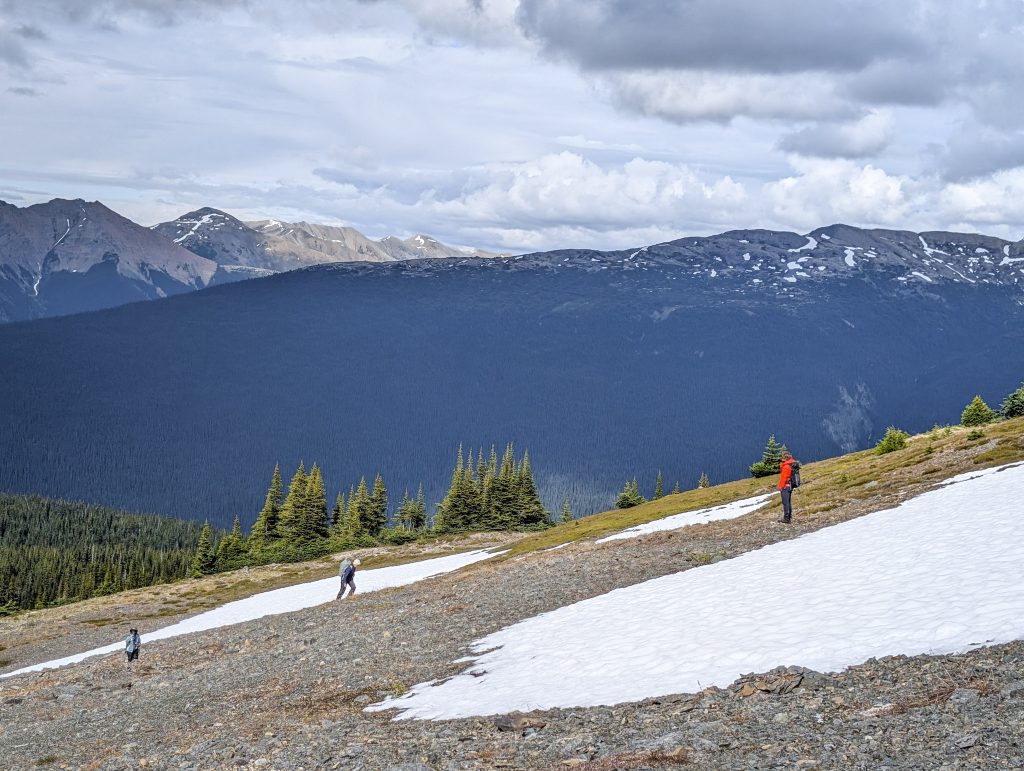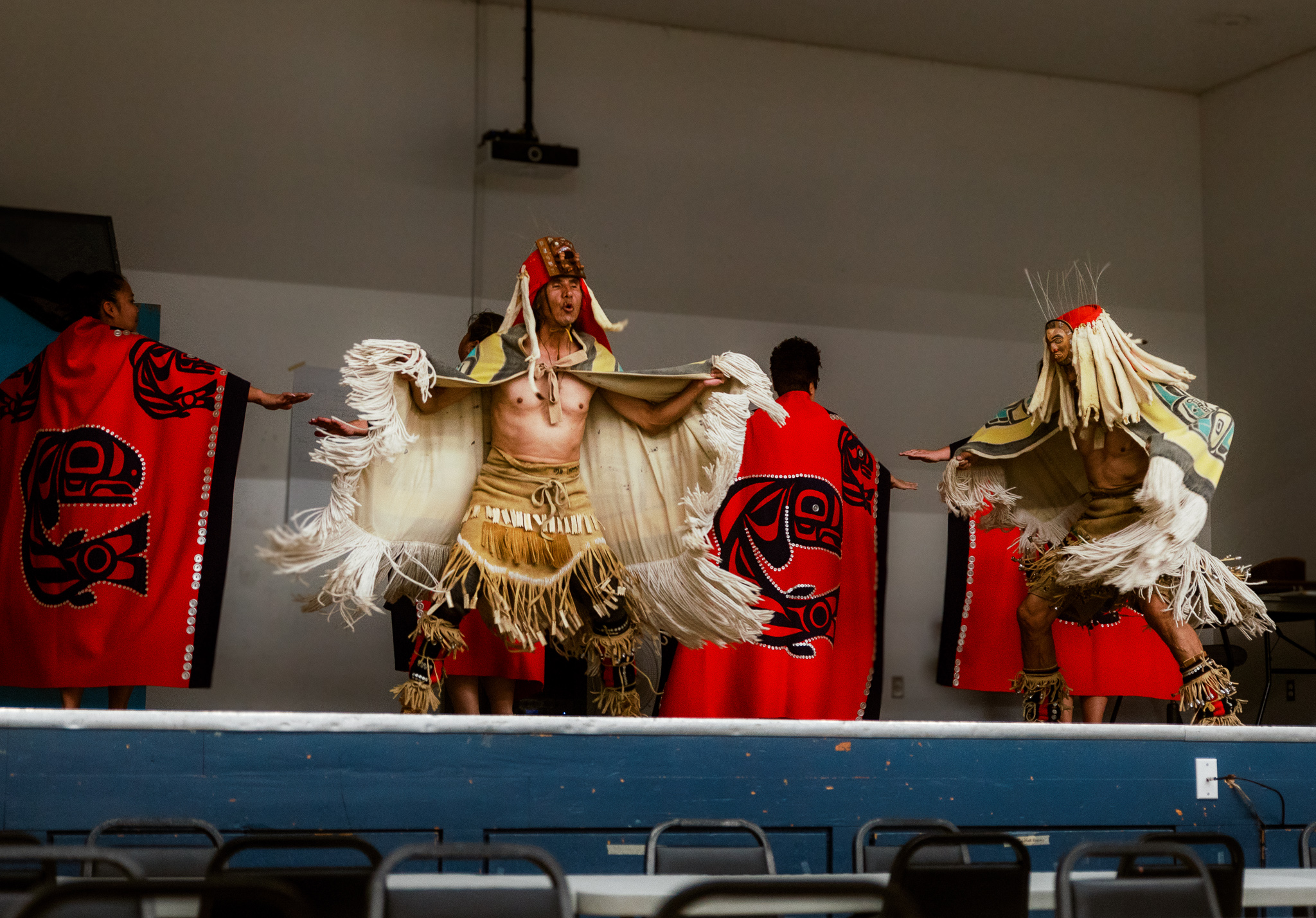 Deep in the upper Skeena watershed, I was on what felt like a never-ending hike through the dense forest. We had been traversing for over an hour since we left the road and climbed deeper into the woods. Branches whipped my face and clung to my clothes as I pushed through. My ankles flared from the terrible rubbing of my brand-new caulk boots, and every step felt heavier than the last. I fell behind as my co-workers, Michelle and Rebecca, along with Brian (K’uukw’lik’ii’sxw), the Lax Yip Stewardship Coordinator from our community partner Wilp Gwininitxw — moved ahead with seemingly effortless strides.
Deep in the upper Skeena watershed, I was on what felt like a never-ending hike through the dense forest. We had been traversing for over an hour since we left the road and climbed deeper into the woods. Branches whipped my face and clung to my clothes as I pushed through. My ankles flared from the terrible rubbing of my brand-new caulk boots, and every step felt heavier than the last. I fell behind as my co-workers, Michelle and Rebecca, along with Brian (K’uukw’lik’ii’sxw), the Lax Yip Stewardship Coordinator from our community partner Wilp Gwininitxw — moved ahead with seemingly effortless strides.
It was late June when we were dropped off in the middle of the wilderness via helicopter for a week of fieldwork. We took this trip to measure how much carbon is stored in this vast forest. This was part of our larger effort to verify that protecting these lands provides significant climate benefits, in addition to cultural and ecological benefits.

In 2023, our team worked remotely with Wilp Gwininitxw to support their application to the federal government’s Nature Smart Climate Solution Fund. A Wilp is a house group, the fundamental unit of Gitxsan legal, social, economic, sustenance and governance systems. Gwininitxw was successful in securing this grant, which brought in additional capacity and resources necessary to advance the permanent protection of the Gwininitxw Protected Area. Since then, we have continued our collaborative relationship, but we have not been to the land in real life… until now.
Right away, the weather seemed to be playing tricks on us. We hiked through scattered thunderstorms and bursts of sun, with the rain and my sweat completely soaking through all my layers. I wanted to stop, but swarms of relentless mosquitoes kept me moving.
This was my second fieldwork trip, and I was nervous about my ability to contribute. As I trudged forward, I asked myself: What am I doing here? I didn’t have years of field experience, and I was terrible with directions. I was slow and barely able to carry myself, let alone help haul heavy gear and soil samples.
I wanted this to be over. I wanted to return to my home office in Toronto, where I could create slides, organize tasks, and follow up on projects from the comfort of my desk. I was lost in a loop of doubts, focused only on putting one foot in front of the other and not falling too far behind on the climb, when Brian and Rebecca called out that they had found a marker for an ancient trail. I was relieved for the pause to catch my breath.
We stood on part of a trail likely used to access the land and travel to camps. Finding this old trail felt special – a living record of how the land was once used and cared for. Long ago, people traveled these paths to trap, trade, and spend time on the land. Today, the forest continues to provide refuge for wildlife, humans, and plants. I caught my breath and a new sense of purpose as we carried onward.
On our last day, we decided to hike up into the alpine to get a sense of the land. I braced myself for another round of bushwhacking, only to be pleasantly surprised when we stayed on a clear, winding path. As we climbed higher, leaving the dense forest behind, the views began to open up.
Brian pointed towards patches of burnt forests far in front of us, explaining they were a healthy mosaic of natural self-managing fires from 2004 and 2009.
“There’s a trail that we’ve marked, blazed and cut from here to that lake,” he said. “We’re following through on the vision of being able to travel all around the territory.”

Having spent over two decades working for the Wilp Gwininitxw, it was clear how deeply Brian knows and loves this land.
As we walked, he shared stories of Yvonne Lattie, Simogyet Gwininitxw (Gitxsan Hereditary Chief). In 2022, Yvonne declared this large section of the upper Skeena Watershed, a 170,000-hectare region without any scars from industrial extraction, an Indigenous Protected Area at a traditional Gwalx Yee’insxw feast. There, she declared the permanent protection of Gwininitxw’s ancestral Laxyip (territory) — Maxhla DiDaat and Galaanhl Giist — as the Wilp Gwininitxw Protected Area under the Gitxsan Ayook (law). One of my colleagues, Celine Trojand, who was the Chief Impact Officer at the time, attended the feast on behalf of Ecotrust Canada. Read our story about the feast here.
Wilp Gwininitxw’s message has been clear and unwavering: to protect the ancestral lands of the watershed for future generations.
I thought back to the first time I met Yvonne on a Zoom call, when she had spoken joyfully about harvesting oolichan. This was the same Indigenous leader, a great-grandmother, who was arrested after standing her ground with other Gitxsan hereditary chiefs defending the land against the 670-km Coastal GasLink pipeline development.[1][2]
As we made it above the tree line, the swarm of bugs finally receded. Crisp air greeted us as we stepped into the sub-alpine area. Birdsong replaced the maddening buzz of mosquitoes, and I finally removed my bug net. For the first time, I could fully take in the breathtaking views of the land: the valley bottom where the Tommy Jack Creek, Sicintine River, and Endless Creek all converge, the mosaic of forests scarred by old fires and new growth, and the rolling ridges of the Slamgeesh Range capped with snow in the distance.
“Everything that you are seeing right now is part of the protected area, the inheritance for future generations of the Wilp and it will remain like this for the benefit of us all,” Brian said as we took in a panoramic view of the land.
In that moment, it all clicked. This was the land Yvonne had devoted her life to defending, not for herself, but for the future. Seeing it with my own eyes, I finally understood why she dedicated herself to protecting her ancestral Laxyip.
Standing here, I thought back to my earlier doubts about whether I could contribute to environmental protection. Coming on this trip wasn’t about proving my competence – it was about connecting with the land and the people who have defended it for decades. Seeing Yvonne’s determination and Brian’s knowledge firsthand, I saw that it takes incredible grit and determination to protect the land for your people and to rise again and again when challenged. Surrounded by the beauty of the Wilp, I gained a renewed sense of responsibility to care for this place.
I walked down the mountain in the same boots that had blistered my feet; my steps were steadier, and my heart was lighter. Back home in Toronto, I know that my climb didn’t end on the mountain – it continues with my Climate Resilience-focused work supporting the Gitxsan stewards to protect their sacred land.
[1] https://www.aptnnews.ca/national-news/three-gitxsan-hereditary-chiefs-arrested-as-solidarity-actions-flare-across-the-country/
















